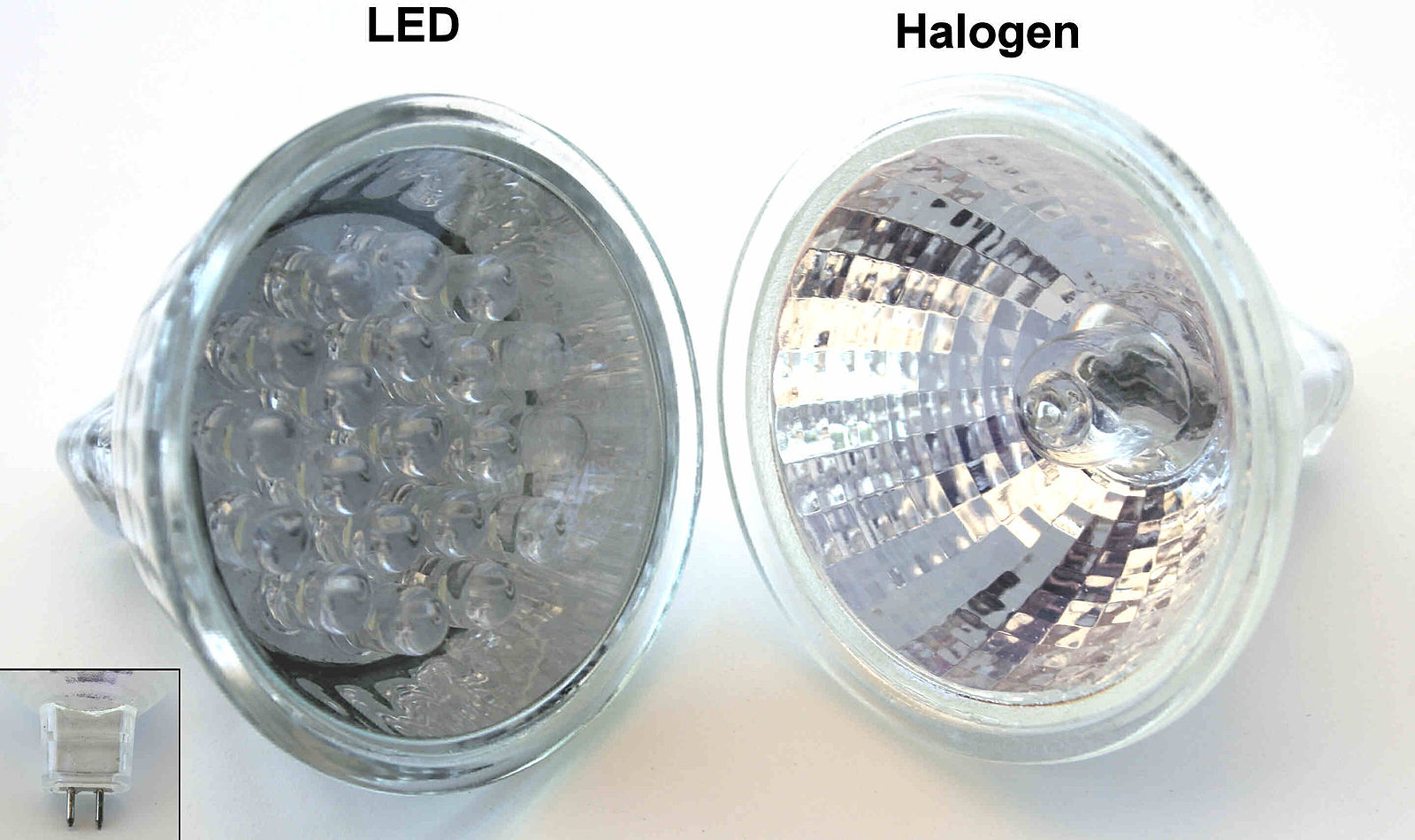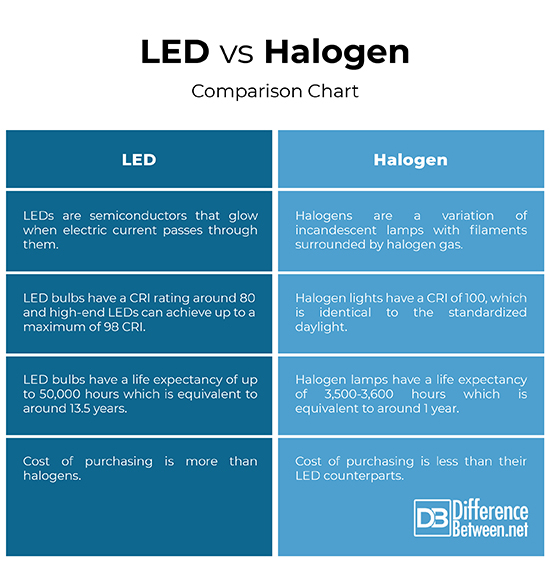Difference Between LED and Halogen
For hundreds of years, people relied on a cheap and easy light source. They used fireplaces, candles, or gas or oil lamps for light. But candles and oil lamps needed a lot of care and they need to be cleaned every day. In the 1800s, people started using gas lamps which burned a gas made from coal or wood. But they were dangerous and people sometimes forgot to turn off the gas after they blew out the flame. The gas would then spread through the house, making people sick. In October 1879, Thomas Edison made a light bulb which glowed for over 13 hours. Today, we have some light bulbs that can last for as long as 10,000 hours. Over time, this great invention has developed into the light bulbs we use today.
Light emitting diodes, or simply called LEDs, and halogen are the two most common lamp types used in both household and commercial lighting systems. Lamps are commonly referred to as light bulbs and they are a replaceable part of a fixture that produces light from electricity. Each type of lamp produces a different lighting color and quality at varying levels of efficiency. Halogens are a variation of incandescent lamps with filaments surrounded by halogen gas inside a compact glass envelope. LEDs have acquired a substantial economical relevance worldwide. LEDs are now used to light everything from homes and offices to streets and warehouses.
What is Light-Emitting Diode (LED)?
LEDs are nothing but semiconductors that glow when electric current passes through them. They are a better alternative to incandescent and fluorescent lamps and they have long been a standard in electronic displays like clocks and stereos. Just as incandescent gave way to the compact fluorescent lamps (CFLs) in our homes, the CFL is yielding to the LEDs. LED technology is nothing new; it’s been around since the early 1900s and for years, we’ve seen LEDs in almost all our electronic equipment, regardless of the device. Recently, high-powered, energy-saving LEDs have started lighting our homes and commercial establishments, with big companies like Philips and General Electric along with a dozen others pushing them into the mainstream.
What is Halogen?
Halogen lamps are a variation on incandescent, using a filament inside a compact glass envelope filled with gas. Halogen lamps are very similar in operation and construction to incandescent light bulbs. However, they are somewhat more efficient than incandescent lamps and the improvements in the design increase the amount of visible light produced and reduce the amount of infrared light emitted. Like an incandescent lamp, halogen lamp uses a tungsten filament but it’s encased in a much smaller quartz envelope which is so close to the filament that ordinary glass would melt. Halogens are often used for accent lighting. Most halogen bulbs have a pin base, which limits their use to fixtures that are designed for the specific bulb type.
Difference between LED and Halogen
Basics of LED and Halogen
– LEDs are semiconductors that glow when electric current passes through them. They come in a number of shapes and forms. Technically, it’s a diode that allows electricity to pass through it in a single direction that emits light. That light can range from infrared to the color spectrum, depending on the semiconductor material that is used. Halogen lamps are a variation on incandescent, using a filament inside a compact glass envelope filled with gas. Like an incandescent lamp, halogen lamp uses a tungsten filament but it’s encased in a much smaller quartz envelope.
Efficacy for LED and Halogen
– Expressed in lumens per watt, efficacy is the ratio of light produced to the amount of energy consumed. In simple terms, it is a measure of how well a light source produces light perceived by the human eye. A 100-watt halogen lamp produces about 1,750 lumens with an efficacy of 17.5, while an equivalent LED bulb may produce 1,400 lumens while using only 15 watts with an efficacy of about 93. The higher the efficacy, the more light is produced for a given amount of energy.
Color Rendering Index
– Color Rendering Index (CRI) is a scale from 0 to 100, indicating a lamp’s ability to render colors the same as a reference lamp type. A CRI rating of 100 is based on a 100-watt incandescent bulb. A CRI between 85 and 90 is considered suitable for residential lighting. Incandescent and halogen lights have a CRI of 100, which is identical to the standardized daylight. LEDs, on the other hand, are not as bright as halogen bulbs so typical LED bulbs have a CRI rating around 80, while some high-end LEDs can achieve up to a maximum of 98 CRI.
Lifespan of LED and Halogen
– Typical lamps have an estimated lifespan ranging from 750 to as long as 100,000 hours, depending on the type of lamp. In addition, the lamp type, the type of use, the brand, and other factors can also affect the lifespan of a lamp. LED lamps’ longevity combined with their high efficacy makes them a better investment on the grounds of their lifespan alone. LED bulbs have a life expectancy of up to 50,000 hours. Halogen lamps, on the other hand, consume more power than their LED counterparts and have a lifespan of around 1 year which is nothing compared to LED’s 10+ years of life expectancy.
LED vs. Halogen: Comparison Chart
Summary of LED verses Halogen
LED and halogen are the two most common lamp types used in both household and commercial lighting systems. LED is technically a semiconductor that glows when electric current passes through it, while halogen lamps are a variation of incandescent lamps with filaments surrounded by halogen gas. While the cost of purchasing of halogen lights are very less than their LED counterparts, they have a significantly low life expectancy compared to LED bulbs. Halogen lamps have a CRI of 100, while LEDs have a CRI rating around 80. In a nutshell, LED lamps’ longevity combined with their high efficacy always makes them a better investment over halogen lamps.
- Difference Between Caucus and Primary - June 18, 2024
- Difference Between PPO and POS - May 30, 2024
- Difference Between RFID and NFC - May 28, 2024
Search DifferenceBetween.net :
Leave a Response
References :
[0]Image credit: https://commons.wikimedia.org/wiki/File:LED_Halogen.jpg
[1]Image credit: https://commons.wikimedia.org/wiki/File:Led.jpg
[2]Toedt, John, et al. Chemical Composition of Everyday Products. Westport, Connecticut: Greenwood Publishing Group, 2005. Print
[3]Kruger, Abe and Carl Seville. Green Building: Principles and Practices in Residential Construction. Boston, Massachusetts: Cengage, 2012. Print
[4]Cangeloso, Sal. LED Lighting: A Primer to Lighting the Future. Sebastopol, California: O'Reilly Media, 2012. Print


